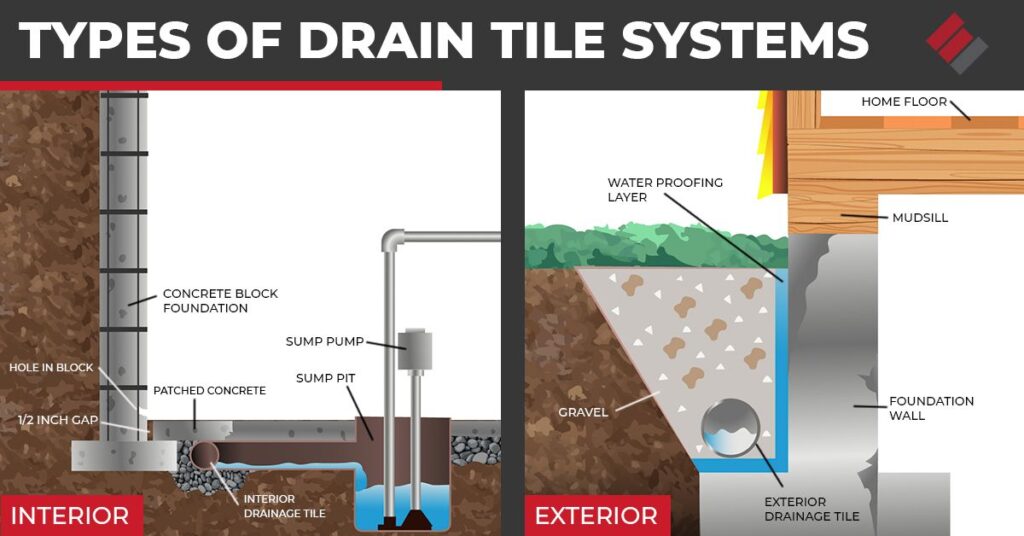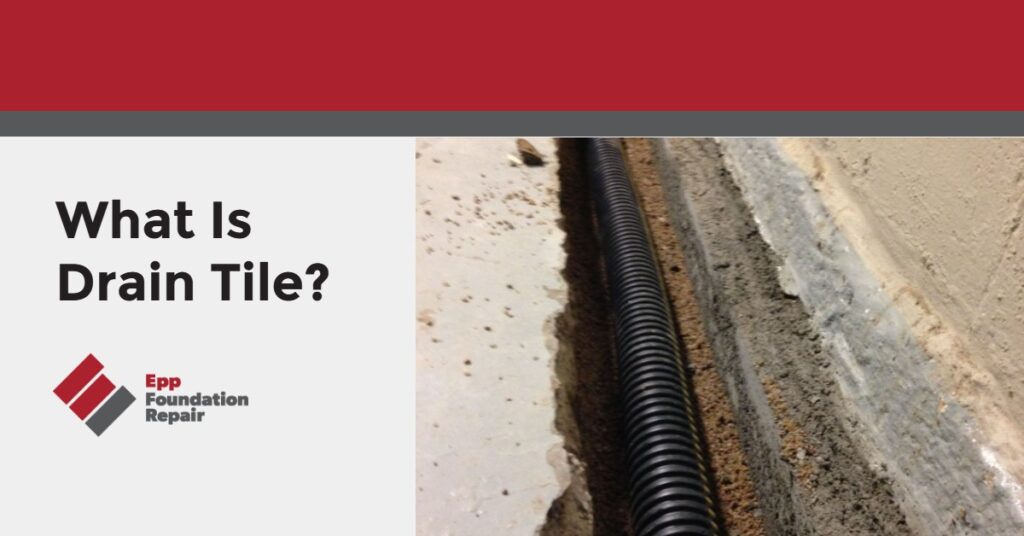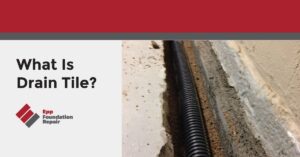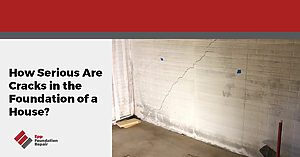Drain tile keeps the soil around your home’s foundation dry by collecting and channeling water away from the foundation. Dry soil is essential because most foundation problems are caused by water in the soil that can’t drain off.
Other names for drain tile include foundation drain, drainage tile, perimeter drain, weeping tile, and French drain. When it comes to getting groundwater under control or waterproofing a basement, drain tile is the gold standard.
In this article, we’re going to talk about drain tile basics, interior vs. exterior drain tile, drain tile pipes, drain tile installation cost, and signs your home might need a drain tile system.
What is drain tile?
Drain tile is a highly effective waterproofing solution that keeps the soil under and around your home’s foundation from getting waterlogged. In a drain tile system, excess moisture at the base of the foundation is channeled into a sump pit and then released away from the foundation via a sump pump. Sometimes, depending on yard slope, the collected water might be released via gravity instead of a sump pump.
Despite the name, there are no tiles in this popular drainage system. The main feature is a 4” perforated pipe. Exterior drain tile is installed outside along the foundation perimeter at the footing level. Interior drain tile is installed under the basement floor.
Newer homes usually have at least an exterior system. Drain tile systems are easy to install during construction. They can also be installed in existing homes, but they require excavation down to the footer (for exterior drain tile) or tearing up the basement slab (for interior drain tile). Installing a drain tile system is a major construction project.

Exterior installation
Exterior drain tile is installed around the outside perimeter of the foundation at the level of the footing. The general installation procedure is as follows:
- The first step is excavation down to the footer.
- A trench is then dug alongside the footer, along with a sump pit.
- The trench is lined with gravel, and then the drain tile pipe is placed into the trench, covered with more gravel and a special fabric to keep soil out.
- Finally, the trench is covered with the previously excavated dirt.
Installing an exterior system in an existing home is a major construction project because of the heavy excavation.
Interior installation
An interior drain tile system is installed under the floor in the basement or crawl space. Interior installations are pretty common in older homes that don’t have an exterior system. The general procedure is as follows:
- Everything is removed from the basement, including any carpeting.
- A jackhammer is used to break up the basement floor.
- A trench is dug around the inside perimeter of the basement, along with a sump pit.
- The trench is lined with gravel, and then the drainpipe is placed into the trench and covered with more gravel.
- If the basement is going to be finished, the trench is covered.
Now, any excess water in the soil under the foundation will be channeled into the sump pit and then ejected by the sump pump.
Two types of pipes
Rigid PVC pipe
Rigid PVC pipe has holes on one side and is placed holes-down in the gravel-lined trench. Because the pipe is rigid, corner fittings are used for direction changes.
Flexible corrugated pipe
Flexible corrugated pipe has tiny holes all over. However, the holes are small enough to keep soil out. Corrugated pipe is less expensive than PVC pipe, and because it’s flexible, it easily bends to go around corners. It’s also very durable in both hot and cold temperatures.
Installation cost
The installation cost depends on various factors, including your geographical location, whether the system is exterior or interior, the type of pipe used, whether it will be installed in an existing house or one currently under construction, etc.
Therefore, we can’t give you even a ballpark figure. The only way to know for sure is to contact a foundation repair contractor who has experience installing drain tile and ask for an inspection and repair estimate. Most contractors do inspections for free.
Although you might be tempted, we advise against DIY because installation is a major construction project. It’s better to find an experienced contractor you can trust.
If you’re thinking about installing drain tile and you’re in our service area in Nebraska, Iowa, Kansas, and Missouri, contact us for a free inspection and estimate.
How do I know if I have a drain tile system?
The easiest way to know if you have a drain tile system is to look for a sump pit. Typically, if you have a sump pit, you have a drain tile system. If you look inside the sump pit you will be able to see the drain tile coming into it. If you do not see anything coming into the sump pit, then you likely don’t have one.
Does your home need drain tile?
It depends. Your home might not need a drainage system if it sits on soil that drains well. In other words, soil that has a lot of sand and gravel in it. However, even then, it might be a good idea.
If you’re building a new home, drain tile doesn’t cost a lot to install. Therefore, you might as well have it done. Drain tile is also required in most areas of the US for new construction projects.
If you’re trying to sell a home, drain tile will make your home more attractive to buyers, and if you’re buying a home, look for one that already has drain tile installed.
Contact us for a repair estimate if you’re thinking about drain tile for your home and you’re in our service area in Lincoln, Omaha, Kearney, Nebraska, Missouri, Iowa and parts of Northeastern Kansas.







